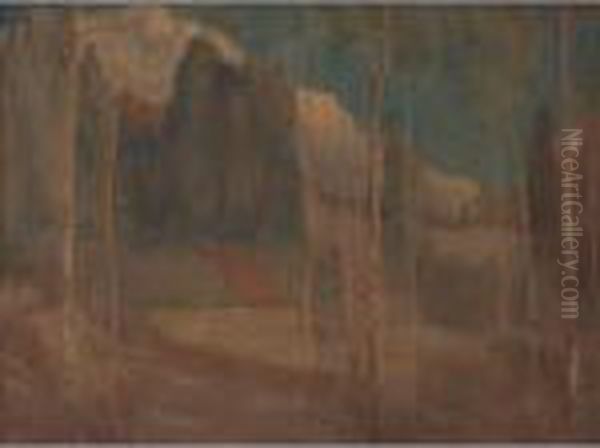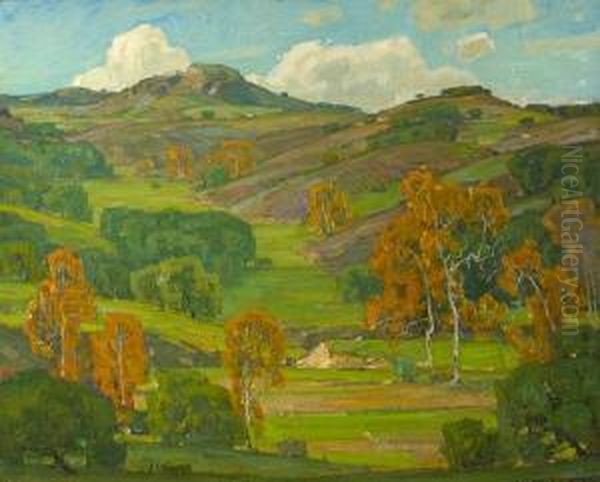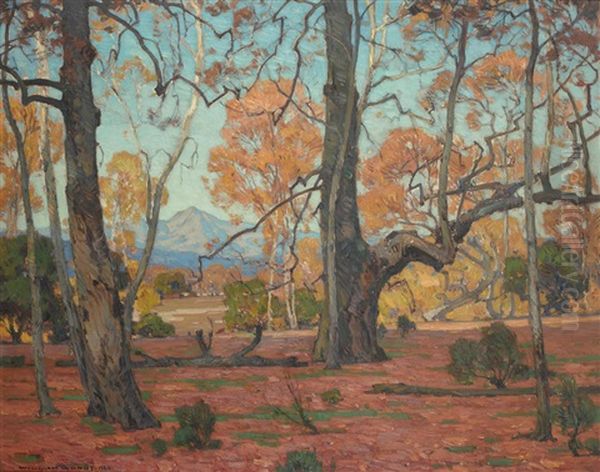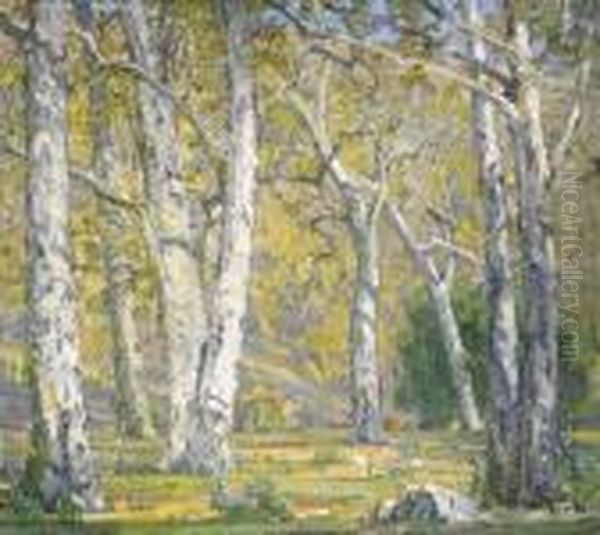William Wendt (1865-1946) stands as a monumental figure in American art history, particularly renowned for his pivotal role in the development of California Impressionism. Often hailed as the "Dean of Southern California landscape painters" and the "Father of Southern California Art," Wendt dedicated his career to capturing the unique light, rolling hills, and majestic wilderness of his adopted state. His powerful, distinctive style and his leadership within the burgeoning art community cemented his legacy as one of the most significant artists of the American West. His work offers a profound connection to the land, viewed through a lens of reverence and masterful technique.
Early Life and Artistic Awakening
Born Johann Wilhelm Wendt on February 20, 1865, in Bentzen, Prussia (now part of Germany), the artist immigrated to the United States at the age of fifteen, settling in Chicago. The bustling industrial city became the backdrop for his early artistic development. Wendt briefly attended the School of the Art Institute of Chicago, but like many artists of his generation, he was largely self-taught. His formal training was minimal, overshadowed by his innate talent and relentless drive to master his craft through observation and practice.
Initially, Wendt supported himself as a commercial artist, working in a commercial paint shop. This practical experience likely provided him with a fundamental understanding of pigments and materials. However, his true passion lay not in commercial design or figurative work, but in the depiction of the natural world. Gradually, landscape painting began to dominate his artistic pursuits, setting the stage for his future career trajectory. Chicago's art scene, while growing, could not fully satisfy his yearning for untamed nature.
The Lure of California and Artistic Partnership
The 1890s marked a turning point for Wendt. Alongside his close friend and fellow painter, George Gardner Symons, Wendt embarked on several painting expeditions to Southern California. These trips proved transformative. The dramatic landscapes, bathed in a quality of light vastly different from the Midwest, captivated him. He and Symons explored the coastal regions and inland valleys, sketching and painting en plein air, capturing the raw beauty they encountered. These early works began to showcase his burgeoning talent for landscape interpretation.

A significant boost came in 1893 when Wendt decided to leave his commercial work behind and dedicate himself fully to fine art. The following year, his growing reputation was affirmed when he received the prestigious Yerkes Prize (and $200) at the Chicago Society of Artists exhibition. This award provided not only recognition but also the financial means to further pursue his artistic goals, likely facilitating more extensive travel, including return trips to California. The state's unique topography and vibrant atmosphere had firmly taken root in his artistic imagination.
Settling in the Golden State: Laguna Beach
The allure of California proved irresistible. In 1906, Wendt made the definitive move, relocating to Los Angeles. That same year, he married Julia Bracken, a talented and recognized sculptor he had met in Chicago. Their partnership was both personal and professional; they shared a deep commitment to their respective arts. Together, they sought a location that offered both natural beauty and a supportive artistic community, finding it in the coastal village of Laguna Beach.
In Laguna Beach, William and Julia Wendt purchased land and built a home and studio, establishing themselves as central figures in what would become one of California's most important art colonies. Wendt's presence was magnetic; his dedication and artistic vision attracted other painters and sculptors to the area. He became deeply involved in the local art scene, playing an instrumental role in the founding of the Laguna Beach Art Association in 1918, an organization crucial to the promotion and exhibition of local artists' work, which eventually led to the establishment of the Laguna Art Museum.
Artistic Style: Masculine Impressionism and Nature's Majesty
Wendt's style is often categorized within California Impressionism, yet it possesses distinct characteristics that set it apart. While influenced by the French Impressionists' focus on light and color, and perhaps the tonal qualities of artists like George Inness or the decorative compositions of Arthur Mathews, Wendt forged a path uniquely his own. His work is frequently described as having a "masculine" quality, characterized by bold, vigorous brushwork and a strong sense of underlying structure.
He employed thick impasto, applying paint in short, decisive strokes that built up textured surfaces, giving his landscapes a tangible, almost sculptural quality. His palette was often dominated by rich greens, deep blues, earthy browns, and golden ochres, reflecting the specific colors of the California terrain under varying light conditions. Unlike the often fleeting, atmospheric effects sought by some Impressionists like Claude Monet or Camille Pissarro, Wendt focused on the enduring, monumental aspects of nature – the solidity of hills, the strength of ancient oaks, the vastness of the sky.

Wendt developed a remarkable ability to convey the interplay of light and shadow across complex forms, capturing the specific atmospheric conditions of Southern California. His compositions are typically well-structured and balanced, often simplifying forms to emphasize their essential character. He rarely included figures or animals in his mature works, preferring to let the landscape speak for itself, presenting an unadulterated vision of nature's power and serenity. This approach differed from contemporaries like Guy Rose, who sometimes incorporated figures into his California scenes.
Philosophy: Nature as Sanctuary
Underpinning Wendt's artistic practice was a profound, almost spiritual reverence for nature. He saw the natural world as a manifestation of the divine, a place of solace and truth away from the encroachments of industrialization and urbanization, which he reportedly disliked. This philosophy, echoing perhaps the sentiments of earlier American Transcendentalists like Emerson and Thoreau, or the spiritual landscape interpretations of the Hudson River School painters like Thomas Cole, permeated his work.
He considered himself not merely a painter of landscapes, but an "interpreter" of nature's truths. His paintings were acts of devotion, attempts to convey the inherent dignity, strength, and sacredness he perceived in the California wilderness. Titles such as Where Nature's God Hath Wrought explicitly reveal this spiritual connection. This deep respect for the land distinguishes his work, imbuing it with a sense of gravity and timelessness that transcends mere representation.
Key Subjects: The California Landscape
Wendt's primary subject was the California landscape in its myriad forms. He painted the rolling hills of the coastal ranges, often dotted with venerable oak trees or sycamores. The canyons and valleys, particularly around Laguna Beach and further inland, were frequent subjects. He was particularly drawn to the majestic Sierra Nevada mountains, capturing their rugged peaks and expansive vistas with a sense of awe and grandeur comparable, in spirit if not style, to earlier Western painters like Albert Bierstadt or Thomas Moran.
His focus remained steadfastly on the undeveloped, "uncultivated" aspects of the landscape. He sought out scenes that conveyed a sense of permanence and natural order. While other California Impressionists, such as Alson S. Clark or Franz Bischoff, might depict gardens, missions, or coastal towns, Wendt consistently turned his gaze towards the wilder aspects of the state, emphasizing its inherent structure and enduring beauty. The changing seasons, particularly the vibrant greens of spring and the golden hues of late summer and autumn, were rendered with particular sensitivity.
Leadership and the California Art Club

William Wendt was not only a prolific painter but also a crucial organizer and leader within the California art community. He was a founding member of the California Art Club (CAC) in 1909, an organization established to promote and exhibit the work of professional artists in the state, setting high standards for artistic quality. The CAC quickly became the most influential art organization in Southern California.
Wendt served as the CAC's president for six crucial years, from 1911 to 1917. During his tenure, he worked tirelessly to elevate the status of California art, organizing important exhibitions, including traveling shows that brought the work of California artists to national attention. He championed the plein air approach and the Impressionist aesthetic, helping to define and solidify the California Impressionist movement. His leadership provided stability and direction during the club's formative years, fostering a sense of camaraderie and shared purpose among artists like Edgar Payne, Granville Redmond, and Maurice Braun.
Representative Works and Recognition
Throughout his long career, Wendt produced a significant body of work, much of which is now highly sought after. Among his most celebrated paintings is The Mantle of Spring, a vibrant depiction of California hills bursting with the fresh greens of the season, showcasing his mastery of color and energetic brushwork. Another notable work, Of Days Gone By, likely evokes a sense of nostalgia and the enduring beauty of the landscape. Many of his paintings bear simple, descriptive titles like California Landscape, Sycamores, or Patriarchs of the Grove, reflecting his direct engagement with his subjects.
Wendt received numerous accolades during his lifetime, affirming his national reputation. While sources sometimes vary on the exact medal, he received significant awards at major expositions: a Bronze Medal at the Pan-American Exposition in Buffalo (1901), a Silver Medal at the Louisiana Purchase Exposition (St. Louis World's Fair) in 1904, and a Silver Medal at the Panama-Pacific International Exposition in San Francisco (1915). He was elected an Associate of the National Academy of Design in New York in 1912, a significant honor for a West Coast artist at the time.
Relationships with Fellow Artists

Wendt's career unfolded within a vibrant network of artists. His early partnership with George Gardner Symons was foundational. His marriage to sculptor Julia Bracken Wendt created a dynamic artistic household. He maintained close ties with many members of the California Art Club and the Laguna Beach art colony. His style, particularly the strong structural elements and bold application of paint, finds parallels in the work of his contemporary Edgar Payne, another giant of California landscape painting known for his depictions of the Sierras and coastal scenes.
While generally respected and collegial, the art world inevitably involved elements of competition. Wendt's dominant position and distinct style naturally placed him in dialogue, and sometimes contrast, with other leading figures. His approach differed from the more lyrical style of Guy Rose or the Tonalist leanings sometimes seen in the work of Granville Redmond. Compared to East Coast Impressionists like Childe Hassam or William Merritt Chase, Wendt's work often felt more rugged and grounded in the specific character of the Western landscape. His interactions with artists like Anna Hills and Frank Cuprien in Laguna Beach further shaped the local artistic discourse.
Later Years and Enduring Legacy
As the years passed and artistic styles began to shift towards Modernism, Wendt remained largely committed to his established vision. While he continued to paint with vigor, he gradually withdrew somewhat from the organizational activities that had defined his earlier career, preferring the solitude of his studio and his direct communion with nature. Some suggest this withdrawal was partly fueled by his aversion to the increasing development and modernization of Southern California.
William Wendt passed away in Laguna Beach on December 29, 1946. He left behind a powerful legacy, not only through his extensive body of work but also through his profound influence on the course of California art. His paintings are held in major museum collections across the United States, including the Los Angeles County Museum of Art (LACMA), the Smithsonian American Art Museum (formerly the National Museum of American Art), the National Academy of Design Museum, the Irvine Museum Collection at the University of California, Irvine, and the Laguna Art Museum.
Conclusion: An Interpreter of the California Soul
William Wendt's contribution to American art is undeniable. As a key founder and leader of the California Impressionist movement, he helped shape a distinct regional style that celebrated the unique beauty of the Golden State. His powerful brushwork, rich color palette, and deep, almost spiritual connection to the landscape set his work apart. He was more than a painter of scenes; he was an interpreter of the land's enduring character, its strength, and its majesty. Through his art and his leadership, Wendt not only captured the essence of the California landscape but also elevated it, securing its place within the broader narrative of American art history. His title as the "Dean of Southern California landscape painters" remains richly deserved.